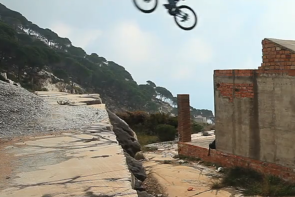In the summer, I carry a minimal set of things in my hydration pack in case I run into problems on the trail: a pump, multi-tool, tube, and, occasionally, a Clif bar or equivalent. I pretty much use the same collection of items whether I’ve been racing, training or if I’m just out for a fun ride. I have kept the same basic set in my pack when fat biking and I hadn’t given it much thought until just recently.

In the winter, my riding is actually quite a bit different than in the summer months. I’m more inclined to explore deeper into remote, unpopulated areas than during the summer. The snow covers over wet areas, dense brush and other impediments to riding found in the non-winter months allowing me to get into areas that I otherwise wouldn’t. Fortunately, I haven’t actually run into any problems while riding my fat bike during the winter, at least not yet. I’ve been doing some large loops through some undeveloped areas on my last few rides, and my mind started wandering a little bit thinking about what I would need if I ran into a mechanical or other problem. Riding into remote areas combined with the much colder weather and snow probably changes my needs a little – actually leaning more towards the survival end of the spectrum rather than mere convenience. I’m not thinking about extended hauls like bike packing, but more for the one day or multi-hour type of ride. It is still easy for things to become a problem where having to bail out of a ride on foot entails a multi-hour slog in sub-zero temperatures through snow. Here are some things I pack when riding in the winter:
- tools. Generally this is taken care of by packing a multi-tool. I also pack a set of tire levers. I can pull a tire off the rim without them, but I’m not as confident about that ability when the temperatures are in the single-digits and I need to wear gloves or mittens.
- spare tube. I hope I never need to attempt this change in the snow but I figure it’ll be better than walking miles in the snow.
- water. Yes, you can get dehydrated in the winter. In fact, you run a greater risk of hypothermia if you are not properly hydrated. Keeping that water from freezing is another challenge. For now, I keep a bottle or two inside one of my panniers. If it is warmer, I’ll use the bottle cages, but things tend to freeze up quickly there.
- spare gloves or mittens. Cold hands can turn a ride into a death-march exploring the lower reaches of misery in no time. It’s easy for gloves to get sweaty and then turn icy cold. I carry some liners and a spare pair of mittens so I can adjust to conditions either direction.
- light. With the short days in the winter, I often end up riding after dark. Even an after work ride can quickly end up being a night ride. Probably equally important is to carry a spare light for night rides in case the headlight fails or I need to work on the bike for some reason.
- food. Again, getting lost or having to revert to foot will make hydration and food important. It’s easy to burn a lot of calories if you’re out in the cold for an extended period of time. This is more about survival than just extending the ride. Bonking in the cold can be dangerous. I generally carry a spare energy bar, even if I don’t intend to eat it.
- hand warmers. Not a bad idea to store a pair just in case. They could help with cold feet too. The only time I’ve ever gotten frostbite was while riding my bike in the winter. It’s NOT a fun experience.
- matches. (or lighter) This might be a good idea just in case things go south in a really bad way. Being able to make a fire in a pinch can mean survival and being found in extreme situations.
- extra layers. I ride with panniers that allow me to bring along some extra or pack a layer if I’m over dressed. Remember, getting too hot can be almost as quick of a path to freezing as wearing too little.
- Cell phone. Some people might be inclined to carry a cell phone instead of a spare tube or other tools. You can’t always count on having cell coverage out in the woods, but it’s still a not a bad idea to have one with you as a safety net.
What do you think? I’m not really a fan of overloading the bike, but it seems like packing a few extras might be wise during the colder weather. I’d love to hear what others bring or don’t bring along when riding in the winter.




I like to carry my puffy coat too. It’s goose down and compresses to the size of a grapefruit. On days when it is zub zero it helps regulate body temp big time. I only take it out when taking a break or if I have a mechanical issue that requires sitting around. Imagine getting injured on the trail and having to wait for help! Once you’re not moving your body temp plummets. A puffy coat could be a life saver.
I never leave the house without a mickey of Fireball. Great for warming your heart and sharing communicable diseases with friends.